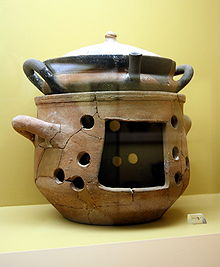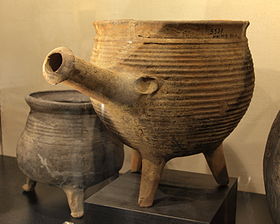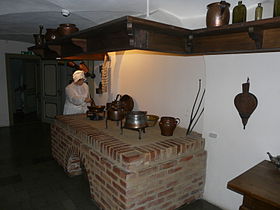The history of cooking vessels before the development of pottery is minimal due to the limited archaeological evidence. The earliest pottery vessels, dating from 19,2000–20,000 BP, were discovered in Xianrendong Cave, Jiangxi, China. The pottery may have been used as cookware, manufactured by hunter-gatherers. Harvard University archaeologist Ofer Bar-Yosef reported that "When you look at the pots, you can see that they were in a fire."It is also possible to extrapolate likely developments based on methods used by latter peoples. Among the first of the techniques believed to be used by stone age civilizations were improvements to basic roasting. In addition to exposing food to direct heat from either an open fire or hot embers it is possible to cover the food with clay or large leaves before roasting to preserve moisture in the cooked result. Examples of similar techniques are still in use in many modern cuisines.

Of greater difficulty was finding a method to boil water. For people without access to natural heated water sources, such as hot springs, heated stones could be placed in a water-filled vessel to raise its temperature (for example, a leaf-lined pit or the stomach from animals killed by hunters). In many locations the shells of turtles or large mollusks provided a source for waterproof cooking vessels. Bamboo tubes sealed at the end with clay provided a usable container in Asia, while the inhabitants of the Tehuacan Valley began carving large stone bowls that were permanently set into a hearth as early as 7000 BC.

According to Frank Hamilton Cushing, native American cooking baskets used by the Zuni (Zuñi) developed from mesh casings woven to stabilize gourd water vessels. He reported witnessing cooking basket use by Havasupai in 1881. Roasting baskets covered with clay would be filled with wood coals and the product to be roasted. When the thus hardened clay separated from the basket, it would become a usable clay roasting pan in itself. This indicates a steady progression from use of woven gourd casings to waterproof cooking baskets to pottery. Other than in many other cultures, native Americans used and still use the heat source inside the cookware. Cooking baskets are filled with hot stones and roasting pans with wood coals. Native Americans, both in the East and in the West, would form a basket from large leaves to boil water, according to historian and novelist Louis L'Amour. As long as the flames did not reach above the level of water in the basket, the leaves would not burn through.
The development of pottery allowed for the creation of fireproof cooking vessels in a variety of shapes and sizes. Coating the earthenware with some type of plant gum, and later ceramic glazes, converted the porous container into a waterproof vessel. The earthenware cookware could then be suspended over a fire through use of a tripod or other apparatus, or even be placed directly into a low fire or coal bed as in the case of the pipkin. Ceramics (including stoneware and glass) conduct poorly, however, so ceramic pots must cook over relatively low heats and over long periods of time (most modern ceramic pots will crack if used on the stovetop, and are only intended for the oven). Even after metal pots have come into widespread use, earthenware pots are still preferred among the less well-off, globally, due to their low production cost.
The development of bronze and iron metalworking skills allowed for cookware made from metal to be manufactured, although adoption of the new cookware was slow due to the much higher cost. After the development of metal cookware there was little new development in cookware, with the standard Medieval kitchen utilizing a cauldron and a shallow earthenware pan for most cooking tasks, with a spit employed for roasting.

By the 17th century, it was common for a Western kitchen to contain a number of skillets, baking pans, a kettle and several pots, along with a variety of pot hooks and trivets. In the American colonies, these items would commonly be produced by a local blacksmith from iron while brass or copper vessels were common in Europe and Asia. Improvements in metallurgy during the 19th and 20th centuries allowed for pots and pans from metals such as steel, stainless steel and aluminum to be economically produced.





